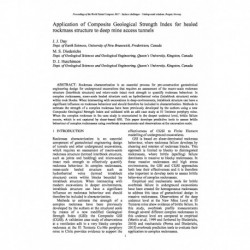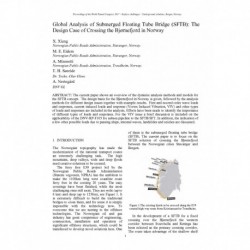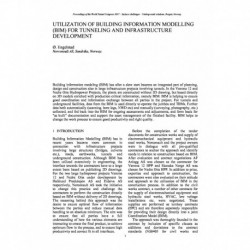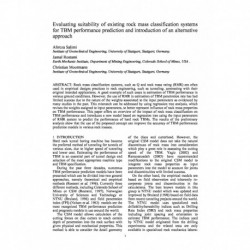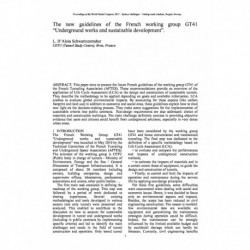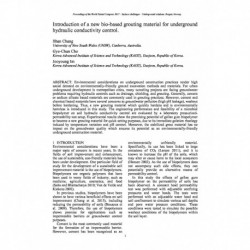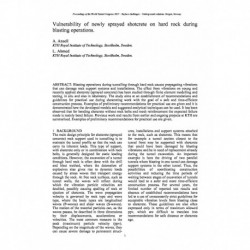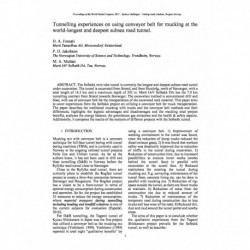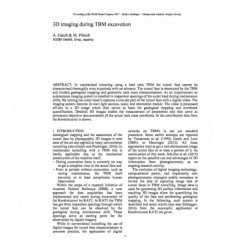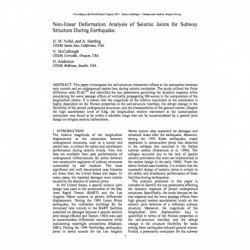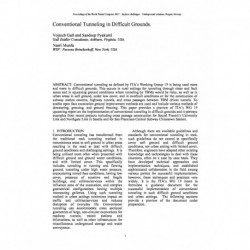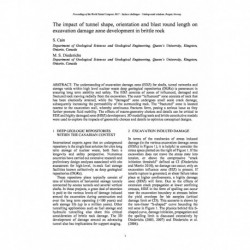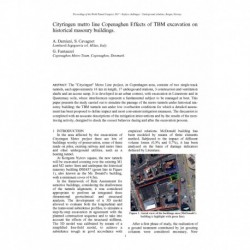No document
Search & filter
Search for a publication
Search & filter
Papers from WTC and ITA conferences have been made available as PDF documents.
ProceedingsThere are 1984 documents.
List of endorsed conferences
-
WTC
World Tunnelling Congress
-
Block Sawing Experiment Related to Excavation Disturbed Zone Studies in ONKALO Underground Research Laboratory
Abstract: In Finland Posiva Oy's will implement the final disposal of the spent nuclear fuel of its owners in Olkiluoto, crystalline bedrock. At a moment, the reference method for excavation is drill and blast method, which causes excavation damaged zone (EDZ) on tunnel surfaces. To control the formation of the EDZ during the construction of the tunnels is important, because the EDZ is seen as risk for...
0,00 € -
Mitigation works prior to soft ground tunnelling with low cover for the Copenhagen Cityringen Metro
Abstract: The Copenhagen Cityringen is currently under construction and due to expand the current Metro system by 17 new stations in 2019. The Cityringen crossing above the existing Metro tunnels at Kongens Nytorv in Copenhagen, Denmark necessitates shallow tunnelling in soft ground with EPB tunnel boring machines, beneath heritage buildings on shallow foundations in the historic centre of the city. The...
0,00 € -
Application of Composite Geological Strength Index for healed rockmass structure to deep mine access tunnels
Abstract: Rockmass characterization is an essential process for pre-construction geotechnical engineering design for underground excavations that requires an assessment of the macro-scale rockmass structure (interblock structure) and micro-scale intact rock strength to quantify rockmass behaviour. In complex rockmasses, meso-scale healed structure such as hydrothermal veins (intrablock structure) exists...
0,00 € -
Global Analysis of Submerged Floating Tube Bridge (SFTB): The Design Case of Crossing the Bjørnefjord in Norway
Abstract: The current paper shows an overview of the dynamic analysis methods and models for the SFTB concept. The design basis for the Bjørnefjord in Norway is given, followed by the analysis methods for different design issues together with example results. First and second order wave loads and responses, current induced loads and response (Vortex Induced Vibration, VIV) and other types of loads and...
0,00 € -
Utilization of building information modelling (BIM) for tunneling and infrastructure development
Abstract: Building information modeling (BIM) has after a slow start become an integrated part of planning, design and construction also in large infrastructure projects involving tunnels. In the Vamma 12 and Nedre Otta Hydropower Projects, the plants are constructed without 2D drawing, but based directly on 3D models enriched with production critical information, namely BIM. BIM is helping to ensure...
0,00 € -
EPB excavation of less than five meters below the historic structure of Chandpole Gate on the Jaipur Metro...
Abstract: The tunnels excavated by Continental Engineering Corporation (CEC) for the underground section of the Jaipur Metro project faced the usual challenges posed by metro projects worldwide, including small site footprints, and the associated problems regarding segment and muck storage space, etc. These challenges were, however, relatively straightforward when compared to the challenges...
0,00 € -
Evaluating suitability of existing rock mass classification systems for TBM performance prediction and...
Abstract: Rock mass classification systems, such as Q and rock mass rating (RMR) are often used in empirical designs practices in rock engineering, such as tunneling, contrasting with their original intended applications. A good example of such cases is estimation of TBM performance in various ground conditions. However, the use of RMR in estimation of TBM penetration rate has had limited success due to...
0,00 € -
The new guidelines of the French working group GT41 “Underground works and sustainable development”
Abstract: This paper aims to present the future French guidelines of the working group GT41 of the French Tunneling Association (AFTES). These recommendations provide an overview of the application of Life Cycle Assessment (LCA) to the design and construction of sustainable tunnels. They describe the methodology to be applied depending on goals and available information. LCA enables to evaluate global...
0,00 € -
Introduction of a new bio-based grouting material for underground hydraulic conductivity control
Abstract: Environmental considerations on underground construction practices render high social demand on environmentally-friendly ground excavation methods and materials. For urban underground development in metropolitan cities, many tunneling projects are facing groundwater problems requiring hydraulic controls such as drainage, shielding, and grouting. Generally, cement or sodium silicate based...
0,00 € -
Vulnerability of newly sprayed shotcrete on hard rock during blasting operations
Abstract: Blasting operations during tunnelling through hard rock causes propagating vibrations that can damage rock support systems and installations. The effect from vibrations on young and recently applied shotcrete (sprayed concrete) has been studied through finite element modelling and testing, in situ and also in laboratory. The study aims at an establishment of recommendations and guidelines for...
0,00 € -
Tunnelling experiences on using conveyor belt for mucking at the world-longest and deepest subsea road tunnel
Abstract: The Solbakk twin tube tunnel is currently the longest and deepest subsea road tunnel under excavation. The tunnel is excavated from Strand, and from Hundvåg, north of Stavanger, with a total length of 14.3 km and a maximum depth of 292 m. Marti IAV Solbakk DA has the 7.9 km tunnelling contract from Strand towards Stavanger. The excavation method is conventional drill and blast, with use of...
0,00 € -
3D imaging during TBM excavation
Abstract: In mechanised tunneling using a hard rock TBM the tunnel face cannot be characterised thoroughly even at periods with no advance. The tunnel face is obstructed by the TBM and hinders geological mapping and geometric rock mass characterisation. As an improvement an autonomous imaging system is installed in inspection openings of the cutter head during maintenance shifts....
0,00 € -
Non-linear Deformation Analysis of Seismic Joints for Subway Structure During Earthquake
Abstract: This paper investigates the soil-structure interaction effects at the connection between twin tunnels and an underground station box during seismic excitation. The study utilized the finite difference code FLAC and identified the key parameters governing the dynamic response while considering the wave passage effects of vertically propagating SH-waves in the computation of the longitudinal...
0,00 € -
Conventional Tunneling in Difficult Grounds
Abstract: Conventional tunneling as defined by ITA’s Working Group 19 is being used more and more in difficult grounds. This occurs in rural settings for tunneling through shear and fault zones and in squeezing ground conditions where tunneling by TBMs would be risky, as well as in urban areas in soft ground, under low cover, and in overbuilt conditions or for the construction of subway station caverns,...
0,00 € -
The impact of tunnel shape, orientation and blast round length on excavation damage zone development in brittle rock
Abstract: The understanding of excavation damage zone (EDZ) for shafts, tunnel networks and storage voids within high level nuclear waste deep geological repositories (DGRs) is paramount in ensuring long term stability and safety. The EDZ consists of zones of influenced, damaged and fractured rock moving radially from the excavation. The outer “influenced” zone consists of rock that has...
0,00 € -
Cityringen metro line Copenhagen Effects of TBM excavation on historical masonry buildings
Abstract: The "Cityringen" Metro Line project, in Copenhagen area, consists of two single-track tunnels, each approximately 16 km in length, 17 underground stations, 3 construction and ventilation shafts and an access ramp. It is developed in an urban context, with excavation in Limestone and in Quaternary soils, where interferences represent a fundamental subject to be managed at best. This paper...
0,00 €




